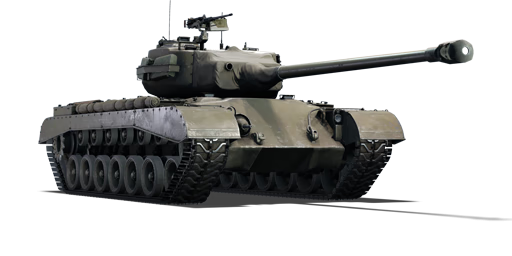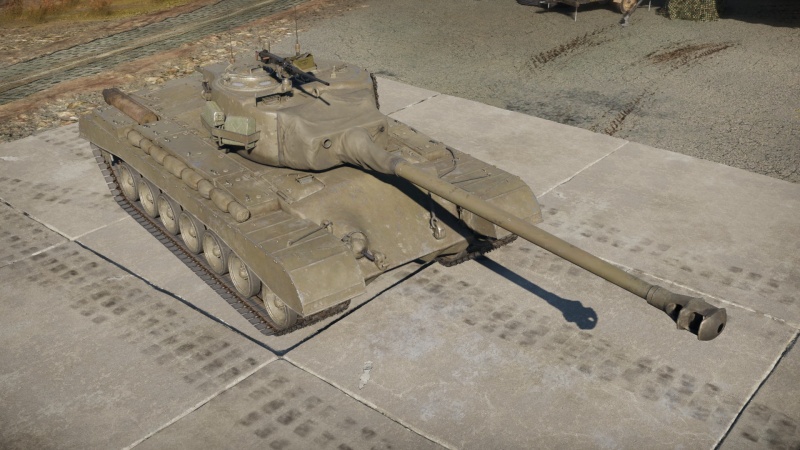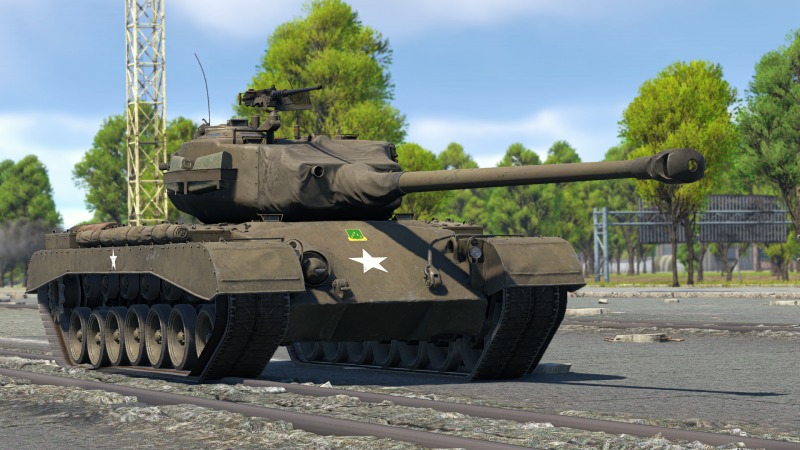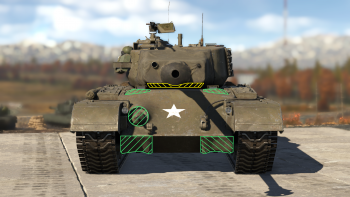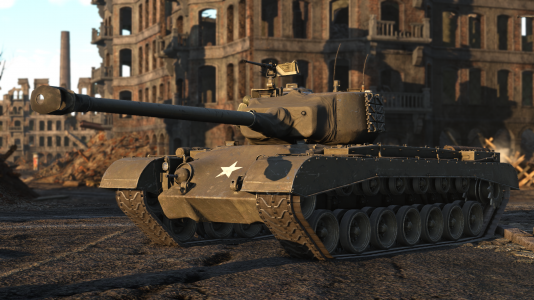T32
| This page is about the American heavy tank T32. For other versions, see T32 Heavy Tank (Family). |
Contents
Description
The Heavy Tank T32 is a rank V American heavy tank with a battle rating of 7.3 (AB/RB/SB). It was one of the first American tanks to be released with the American ground tree in Update 1.45 "Steel Generals". It can be seen as an extremely buffed up version of a M26 Pershing with a high velocity 90 mm gun and extremely tough front turret armour able to exploit hull down positions against its competitors.
The T32 is a post-World War II heavy tank with 7.3 Battle Rating, and it's one of the best tanks for a specific battle tactic known as hull-down. Due to its 298 mm thick frontal turret armour, it will mostly deflect any incoming armour-piercing shells at any range, except incoming High-Explosive Anti-Tank Fin-Stabilized (HEATFS), aimed at the turret hole beneath the mantlet. It's crucial to conceal the T32's weak spots, especially the lower plate tips and lower mantlet since both spots can cause catastrophic damage to the T32.
Even if a T32 is hull-down, doesn't mean it's invulnerable. If an armour-piercing shot deflects at the lower mantlet and penetrates through top hull armour, It will instantly knock out the tank, since the deflected shot goes right through the main ammo load and blows it off. Also, a very powerful HE shot from guns with over 120 mm calibre can cause severe damage to the T32's armour.
It's armed with the 90 mm T15E2 gun, and very effective against most enemies appearing in its Battle Rating range, mainly with late-World War II German and Soviet tanks. The stock ammunition T43 Armoured Piercing shell has good penetration but lack of explosive warhead is not enough to knock out most tanks in a single shot. A concentrated shot has to be very well aimed to seriously damage any enemy. Like most of U.S. tanks, the T32 performs better when armed with newly researched shell, the T41 Armour-Piercing Capped Ballistic Cap. Thus, the ammunition upgrades are very advisable to research first. The T41 shell has the roughly equal penetrating power with the T43 shell but contains 140 grams of explosive warhead inside, deadly enough to destroy any kind of tank in a single successful penetrating shot. Other shell includes T44 Armour-Piercing Composite Rigid, with impressively better penetration but unarmed with explosives. Despite having no explosive at all, APCR is good enough to cook off enemy tank's ammo load or take out critical module parts with an accurate shot. There's also T42 High Explosive shell, which is useful for destroying Self-Propelled Anti-Air vehicles, but rather ineffective against armoured vehicles.
General info
Survivability and armour
The T32 has an impressive 298.4 mm cast homogeneous armour thickness in the gun mantlet and turret cheeks, making it almost impossible to be pierced by traditional full calibre rounds (AP, APC, APCBC), only high velocity, kinetic (APCR, APDS) and chemical rounds (HEAT, HEATFS) can penetrate it. The downside is the bottom of the gun mantlet that is a shot trap. The commander cupola is also well armoured, with 152.4 mm of thickness, it can only be pierced by high-velocity and chemical rounds. The top frontal hull has a slopped 127 mm armour thickness at 54° and the bottom frontal hull with a slopped 95.5 mm armour at 59°, both effective against full caliber rounds and weak against kinetic and HEAT rounds. Otherwise, its hull machine gun is a critical weak spot and bottom hull has two weak spots next to both left and right tracks, with a variable angle that varies from 30° to 44° all those can be pierced by full calibre rounds.
Armour type:
- Cast homogeneous armour (Front glacis, turret, gun mantlet, cupola)
- Rolled homogeneous armour (Hull sides, rear & roof, turret roof, cupola roof)
| Armour | Front (Slope angle) | Sides | Rear | Roof |
|---|---|---|---|---|
| Hull | 127 mm (54-70°) Front Glacis 95.25 mm (26-46°) Lower Glacis |
76.2 mm | 50.8 mm (0-56°) | 38.1 mm |
| Turret | 298.4 mm (8-21°) Turret front 298.4 mm (0-80°) Gun mantlet |
152.4-196 mm (3-42°) | 152.4 mm (0-72°) | 25.4 mm |
| Cupola | 152.4 mm (conical) | 152.4 mm Outer ring 25.4 mm Centre | ||
Notes:
- Suspension wheels are 20 mm and tracks are 30 mm thick.
- MG port weak point is 127 mm + 25.4 mm of armour.
Mobility
| Game Mode | Max Speed (km/h) | Weight (tons) | Engine power (horsepower) | Power-to-weight ratio (hp/ton) | |||
|---|---|---|---|---|---|---|---|
| Forward | Reverse | Stock | Upgraded | Stock | Upgraded | ||
| Arcade | 38 | 15 | 54 | 994 | 1,469 | 18.41 | 27.2 |
| Realistic | 36 | 14 | 681 | 770 | 12.61 | 14.26 | |
Modifications and economy
Armaments
Main armament
| 90 mm T15E2 | Turret rotation speed (°/s) | Reloading rate (seconds) | |||||||||||
|---|---|---|---|---|---|---|---|---|---|---|---|---|---|
| Mode | Capacity | Vertical | Horizontal | Stabilizer | Stock | Upgraded | Full | Expert | Aced | Stock | Full | Expert | Aced |
| Arcade | 54 | -10°/+20° | ±180° | N/A | 19.4 | 26.9 | 32.6 | 36.1 | 38.4 | 18.85 | 16.68 | 15.37 | 14.50 |
| Realistic | 14.3 | 16.8 | 20.4 | 22.6 | 24.0 | ||||||||
Ammunition
- T43; AP - Stock shell, which means it's free to use, but highly recommended to replace with the T41 APCBC once available.
- T41; APCBC - This shell is superior to the above shell in very way, able to penetrate ~10-15mm more armour at all angles and distances as well as an explosive filler to increase post-penetration damage. Post-penetration effects are fantastic, only oversized fighting compartments can survive a successful penetration (e.g. Tortoise, Tiger) if the ammo racks have conveniently been emptied prior. 137 gram of TNT equivalent knocks the Soviet 100 mm D-10T out of the park.
- T44; APCR - Plus ~50 mm penetration on all ranges, looks good on paper, but a further check reveals a great disadvantage. With greater armour angles the penetration quickly drops, bone breaking as angled plates become very common in era IV and V. Additionally, the post-penetration effects are small, so it's best to focus fire on important crewmen and modules to disable the tank momentarily, with direct hits on ammo racks having a good chance (but not guaranteed) to cause an explosion like the T43 AP shot. Best use one might find for this ammo is against tanks with flat armour like the turret cheeks of the Maus at long range, especially over 1000 m where the T41 APCBC shell will be unable to penetrate in comparison.
- T42; HE - Penetration power is nothing to boast about, 1 mm more than the long 88 of the King Tigers, but 2 mm less than of the 90 mm cannons used by Patton's. Damage against common SPAA is satisfactory, but the long reload and good fuse sensitivity make the T41 APCBC shell the better choice. The roof-mounted M2HB Browning heavy machine gun is the better weapon of choice against light vehicles.
| Penetration statistics | |||||||
|---|---|---|---|---|---|---|---|
| Ammunition | Type of warhead |
Penetration @ 0° Angle of Attack (mm) | |||||
| 10 m | 100 m | 500 m | 1,000 m | 1,500 m | 2,000 m | ||
| T43 shot | APBC | 211 | 208 | 193 | 177 | 162 | 148 |
| T42 shell | HE | 26 | 25 | 24 | 22 | 20 | 18 |
| T41 | APCBC | 224 | 220 | 205 | 187 | 171 | 157 |
| T44 shot | APCR | 336 | 330 | 304 | 274 | 248 | 223 |
| Shell details | ||||||||||||
|---|---|---|---|---|---|---|---|---|---|---|---|---|
| Ammunition | Type of warhead |
Velocity (m/s) |
Projectile mass (kg) |
Fuse delay (m) |
Fuse sensitivity (mm) |
Explosive mass (TNT equivalent) (g) |
Ricochet | |||||
| 0% | 50% | 100% | ||||||||||
| T43 shot | APBC | 975 | 10.9 | - | - | - | 47° | 60° | 65° | |||
| T42 shell | HE | 975 | 10.6 | 0.2 | 0.1 | 925 | 79° | 80° | 81° | |||
| T41 | APCBC | 975 | 10.91 | 1.2 | 14 | 137.2 | 48° | 63° | 71° | |||
| T44 shot | APCR | 1,143 | 7.6 | - | - | - | 66° | 70° | 72° | |||
Ammo racks
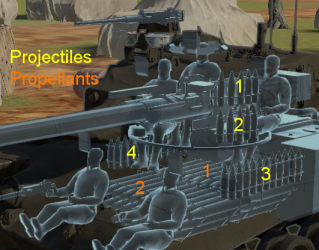
| Full ammo |
Ammo part |
1st rack empty |
2nd rack empty |
3rd rack empty |
4th rack empty |
Visual discrepancy |
|---|---|---|---|---|---|---|
| 54 | Projectiles Propellants |
50 (+4) 28 (+26) |
45 (+9) 1 (+53) |
23 (+31) N/A |
1 (+53) N/A |
No |
Notes:
- The T32 uses two-piece ammunition, composed of projectiles (yellow) and propellant bags (orange). Both have separate racks.
- Packs 23 (+31) shells to have the turret and left flank racks empty.
The cannon takes two-piece ammunition, which explains why it takes so long for the cannon to load despite its 90 mm caliber. The propellant stowage covers the entire floor of the fighting compartment three times over. The projectiles themselves are kept in four racks, two lining both sides of the hull's fighting compartment, and two smaller ones on the port side of the turret in front of the loader.
Machine guns
| 12.7 mm M2HB | ||||
|---|---|---|---|---|
| Mount | Capacity (Belt) | Fire rate | Vertical | Horizontal |
| Pintle | 1,000 (200) | 577 | -10°/+35° | ±120° |
| 7.62 mm M1919A4 | ||||
|---|---|---|---|---|
| Mount | Capacity (Belt) | Fire rate | Vertical | Horizontal |
| Coaxial | 4,000 (250) | 500 | N/A | N/A |
Usage in battles
The playstyle of the T32 is vastly different in each game mode, due to the nature of the gameplay available in Ground Forces:
Arcade battles
- Player, ally, and enemy position will be immediately spotted upon detection with their name indicator visible above their vehicle and on the minimap
- Aim assist is present to help accurate aiming at a target
- Player and enemy team tank's nationality are mixed
The T32 shouldn't be exposed to the enemy at a prolonged time at close range engagement since the enemies will use aim assist to take out the T32 from either lower plate tips or lower turret. On the other hand, the T32 can also utilize these features against the enemy, albeit with much harder difficulty due to rather sub-par penetration against other tanks in Rank IV to reliably achieve first penetration in arcade tank combat. Exercise caution
Realistic battles
- No visible name indicator
- Manual range calculation
- Player and enemy team tank's nationality are not mixed
The T32 can safely mobilize itself due to the dissipation of name indicator above the vehicle, especially with its low profile. In Realistic Battle, the T32 can do almost anything on its own, especially with flanking enemies to deliver a striking blow to the enemy formations, since the sub-par penetration of the T41 APCBC is negated by the enemies' side armour weakness (be aware with IS-4M as it has 160 mm of side armour, expect to use both APCBC and APCR). The T32 excels at flanking than other roles due to characteristics of its gun performance, mobility, and protection.
Simulator battles
- No visible name indicator
- Manual range calculation
- Player and enemy team tank's nationality are not mixed
The T32 can safely mobilize itself due to the dissipation of name indicator above the vehicle, especially with its low profile. In Simulator Battle, the battle tactic is almost similar to Realistic Mode. T32 can do almost anything on its own, especially with flanking enemies to deliver a striking blow to the enemy formations. Since the sub-par penetration of the T41 APCBC is negated by the enemies' side armour weakness (be aware with IS-4M, as it has 160 mm of side armour, expect to use both APCBC and APCR). The T32 excels at flanking than other roles due to characteristics of its gun performance, mobility, and protection.
Other considerations in Simulator mode is the different gun sight placement and 3rd person perspective. The gun sight is tough to control, located on the left side of mantlet. The 3rd person perspective, now in the commander's cupola area, helps the T32 by restricting the enemy's field of vision (although the player is as well) and allow the T32 to move stealthily more easily.
Combat tactics
The T32 can fulfill major roles in battle due to its flexibility at any kind of operation, known as "Jack-of-all-Trades". Its role is not far different than the well-known M26 Pershing. There are 5 known roles that can be used in battle, which are Assault, Flank, Snipe, Support, and the last but not least, Ambush:
- Assault
Leading an assault directly into the enemy forces is the most frequently used tactic, especially in urban areas. It's quite capable to abuse the enemy shots with angling, but not entirely, since battle will mostly take place at very close range (about 0 - 100 m). A strike team is needed to carry out an assault since T32 can't cover its side armour and slow reload time alone. In most cases, a T32 will likely to initiate flanking role to the enemy once it comes up-close to increase the chance of incapacitating a vehicle with a single strike in quick succession.
- Flank
Flanking is the most effective role for the T32. Its characteristics and performances are highly orientated for flanking purpose. At given destructive penetrating power of the T41 Shell from close range, the T32 can critically damage, if not outright knocking out everything from the side. Be aware when initiating the operation, since someone might be trying to flank the flanker. Flanking is also a part of the assault role, albeit with a more focused objective on manoeuvring on the enemies' side. At this rate, the enemies will likely to scatter around to evade, so eliminating any available threat is required to continue the tactic. The armour will greatly aid in this tactic, as return fire is commonly a hasty act, yet be wary of the tank's weak spots! On open terrain keep manoeuvring during reload to throw of aim, alternatively on distances above 400 m drive slightly angled forwards and backwards.
- Snipe
Sniping is frequently used by the T32 when encountering enemies in a large, open map such as Kursk and Mozdok. The T44 APCR is a good option when the target is too far and very fast since the APCBC travels slower than APCR. Locating target is much harder than engaging at close range, since most of the enemies will also be sniping from afar, especially when sharpshooting against German tanks. Fortunately, almost no T32's frontal weak spot will be a viable target when sniping, since the weak spots are much more protected at longer range. It is suggested, if having to play on wide open terrain found on Tunisia, Kursk and Mozdok, to take full ammo load and 50/50 of APCR and APHE.
- Support
Supporting the allies to attack the enemies is a backup plan used to increase the allied forces firepower when attacking the enemies, such as providing covering fire for smaller tank such as T-44 or to increase the combat effort alongside the other heavy tank like Tiger II.
- Ambush'
Ambush is preferable when enemies are unaware of the presence of a concealing T32. It should be commenced at a strategic choke point where the enemies will likely to mobilize their armour from there. Be aware that ambush is only used when the enemies are already identified by allies and heading to the choke point. Otherwise, sitting still and waiting for nothing can burden the team. Keep in mind that 90 mm T15E2 is L/73 length gun (aka very long), so make sure the gun barrel is hidden from the enemy if planning to catch them by surprise.
- "Hunker down"-Support
Move up to an distant open spot, visible from the enemy spawn or main route of attack and begin firing machine guns to draw in attention. The idea is caught the enemies attention and with this bind enemy firepower on something they can physically not destroy from the distance. Both the hostile force and the T32 will be pinned down in a stalemate, subtracting from each team's firepower. Therefore keep in mind the enemy's tank value. If it is only an M26, the T32 may be better off in the Support role, but if it is an IS-4 or several other evenly ranked tanks, then pursuing the hunker down tactic is worthwhile to the team's success.
- Conclusion
Overall, the T32 is a versatile heavy tank with an impressive performance in the game, but since it's not invincible with a fair amount of potential weaknesses, it requires specific knowledge with this tank to survive. The T32 will lead to the pinnacle of the U.S. heavy tank branch – the M103.
Pros and cons
Pros:
- Excellent 298 mm front turret armour
- Sloped front armour has effective ~200 mm thick
- Accurate high-velocity T15E2 cannon
- Splendid destructive power of the T41 APCBC
- Low profile
- Reasonably agile for a heavy tank
- Versatile tank role: sniper, assault, flanker, support, and ambush
- Very efficient in hull-down fighting
Cons:
- Long gun easily knocked out and disabled
- "Shot trap" on the lower part of mantlet can blow the main ammo load entirely
- Bow machine gun port and lower glacis armour are vulnerable front weak points
- Weak lower plate tips
- Rather thin side armour of 76 mm, angling could expose the weaker sides
- Lengthy reload time
- A single shot into the centre main hull can cause the ammo to explode violently
- Overall performance of the vehicle is bad when uptiered
History
Development
Late in the Second World War the US Army began a program to develop a new heavy tank using components of the M26 Pershing. On 8 February 1945, a total of four prototypes were requested. The first two pilot vehicles, designated Heavy Tank T32, were delivered on 15 January 1946 and 19 April 1946 respectively. They were then shipped to Aberdeen Proving Ground for testing. The third and fourth pilots were completed in May and June, but were designated as T32E1s due to having some differences compared to the first two.
Design
The T32 had a combat weight of 120,000 pounds and a crew of five: a driver and assistant driver/machine gunner in the hull and the gunner, loader, and commander in the turret. The hull was based on the Pershing's hull but was modified, while the turret was a new design that simply used M26 components.
The hull was largely similar to the Pershing's except for its length, engine compartment, and frontal armour. The hull was lengthened and a seventh road wheel was added to each side. The torsion bar suspension remained the same but the 23 inch T80E1 tracks from the M26 were fitted with 5 inch extended end connectors for reduced ground pressure. The engine compartment was changed and a new powerplant was fitted. It consisted of a 770 horsepower Ford GAC engine hooked to an EX-120 cross-drive transmission. This powerplant allowed the T32 to achieve a maximum speed of 22 miles per hour (35.4 kilometers per hour).
The frontal armour was increased in thickness to 5 inches (127 mm) at 54 degrees on the upper glacis and 95 mm at 59 degrees on the lower glacis. The side armour stayed at 3 inches (76.2 mm) and the rear armour stayed at 2 inches (50.8 mm). The driver and assistant driver/machine gunner each had an overhead hinged hatch with a wide-view periscope fitted in it. The assistant driver/machine gunner's position also received a .30 cal (7.62 mm) M1919A4 machine gun in a ball mount in the upper glacis.
A newly designed turret was fitted that used some components from the Pershing. The armour ranged from 6 inches (152.4 mm) on the rear to 11¾ inches (298.45 mm) on the front. The main armament fitted was a 90 mm high velocity T15E2 gun, using two piece ammunition. Because of the large two piece ammunition the ammunition stowage had to be redesigned from that of the M26. The gun had an elevation arc of +20° to -10°. A .30 cal (7.62 mm) M1919A4 machine gun was fitted coaxial to the main gun and a .50 cal (12.7 mm) M2HB machine gun could be fitted either on the rear of the turret roof or in front of the commander's cupola. The ammunition capacity was 54 90 mm rounds, 550 12.7 mm rounds, and 4,000 7.62 mm rounds. A radio was located in the turret bustle.
Production and Service
The T32 never entered production or service and neither did the T32E1, mostly just because it came after the war had already ended. On the bright side, the T32 program was the first to test the EX-120 transmission. The transmission was proven to be finicky and maintenance heavy but it later led to the CD-850 series of transmissions which would later see production on American tanks.[1]
| Archive of the in-game description | |
|---|---|
|
In 1944-1945 the Ordnance Department initiated the T29 program, which was the high priority construction of several tanks based on the M26. The end result was the next version of the M26 Pershing. The US ground forces needed a new, modified version of the mass-produced M26 outfitted with thicker armour, heavier weaponry, and an enlarged turret. On February 8, 1945, the construction of four prototypes was approved, with the official T32 designation conferred in March. The tank hull was made from plates of homogeneous armour, and protecting the front section was prioritized. As a result, the armour there was 70-127 mm thick, while the side armour was made with 51-76 mm armour plates and the rear was protected by only 19-51 mm. The thickness of the lower section's front part was expanded to 38 mm, identical to the hull roof. The hull enjoyed a traditional design, though two prototypes had a cast front hull section and the other two had welded components. The turret construction resembled the T29 models, which were larger than the M26 and had a gun mantlet that was expanded to 298 mm. The main weapon was a 90 mm T15E2 cannon with separate tube reloading. The weapon boasted high initial velocity and was good at penetrating armour, outstripping almost every one of its foreign equivalents. Regardless of the work put into the project, the tank could not be completed by the end of the war, after which the T32 program lost its priority status. The conclusion had already been drawn by 1946 that there was no need to mass produce the model, given that M29s with similar weaponry already existed. There were also more powerful tanks in the pipeline. | |
Media
- Images
T32 in Advance to the Rhine
- Skins
- Videos
See also
Links to the articles on the War Thunder Wiki that you think will be useful for the reader, for example:
- reference to the series of the vehicles;
- links to approximate analogues of other nations and research trees.
External links
References
- ↑ Hunnicutt, R. P. (1988). Firepower: A History of the American Heavy Tank. New York, NY: Presidio.
| USA heavy tanks | |
|---|---|
| M4 Jumbo | M4A3E2 · Cobra King · M4A3E2 (76) W |
| M6 | M6A1 · T1E1 · T1E1 (90) · M6A2E1 |
| T26 | T26E1-1 · T26E5 |
| T29/30/34 | T29 · T30 · T34 |
| T32 | T32 · T32E1 |
| M103 | M103 |
| Others | T14 |


